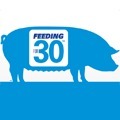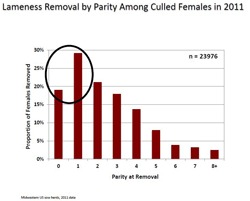
 Sows that leave the herd early have less opportunity to reach their full potential – and less opportunity to pay for themselves. To keep sows in the herd longer, create a lameness prevention strategy.
Sows that leave the herd early have less opportunity to reach their full potential – and less opportunity to pay for themselves. To keep sows in the herd longer, create a lameness prevention strategy.
Zach Rambo, Ph.D., swine research nutritionist for Zinpro Corporation, says preventing sow lameness can promote a balanced parity structure.

“The parity structure of the herd suffers from early culling,” Rambo says. “Sows typically don’t become profitable until their third parity, so we need to keep them in the herd for several parities to reach profitability. Keeping sows in the herd longer begins by understanding why sows are culled early.”
When evaluating reasons for early culling, lameness is a top culprit. In fact, lameness causes many gilts to leave the herd before they even produce a litter. A 2011 survey of Midwestern sow herds in the United States showed that 19 percent of gilts are culled for lameness at parity 0 and an additional 29 percent of sows are culled for lameness in parity 1.[1] That means, by the time you breed for parity 2, lameness has already claimed nearly half of your breeding age animals.
“We’ve invested a lot of resources into our early parity sows and we’re losing a lot of them to lameness,” Rambo says. “When we’re culling young gilts and sows, not only are they not achieving 30 pigs per year, they are not even reaching 30 pigs in their lifetime.”
When adding in decreases in feed intake, reproductive performance and fewer pigs weaned, the University of Minnesota estimates the economic losses of sow lameness at $180 per sow.[2]
In addition to economic benefits, preventing sow lameness allows culling by choice rather than by necessity.
“If we can keep these gilts and young sows healthy and in the herd, we have the opportunity to cull sows based on performance,” Rambo says. “Having a bigger pool of sows to choose from when culling will help improve the genetics of the herd.”
While there are many factors that contribute to lameness, to reduce sow lameness, Rambo recommends evaluating the trace minerals in the ration. Research from Zinpro Corporation indicates that replacing inorganic minerals with trace minerals as metal amino acid complexes is important.
“Optimizing trace mineral programs can help mitigate lameness,” Rambo says, highlighting the importance of feeding a balanced diet that includes complexed zinc, manganese and copper. “These minerals help optimize foot health and reproductive performance.”
Research conducted on five farms in Spain shows that adding zinc, manganese and copper amino acid complexes to sow diets reduced cull rates from reproductive failure and lameness by nearly 20 percent in two years.[3]
“Any reduction in sow lameness can pay big dividends in the herd, because the sows stay in the herd longer and are able to produce more pigs,” Rambo says. “Sometimes a small difference in the ration can have a big impact on herd performance.”
[1] Zinpro Corporation. Midwestern US data. 2011.
[2] Vansickle, Joe, “Sow Lameness Underrated,” National Hog Farmer, http://nationalhogfarmer.com/print/health-diseases/0615-sow-lameness-underrated
[3] Wilson, Mark, “How to optimize sow retention and longevity,” Pig Progress. Dec. 2013.

October 14, 2014 - Feeding for 30


